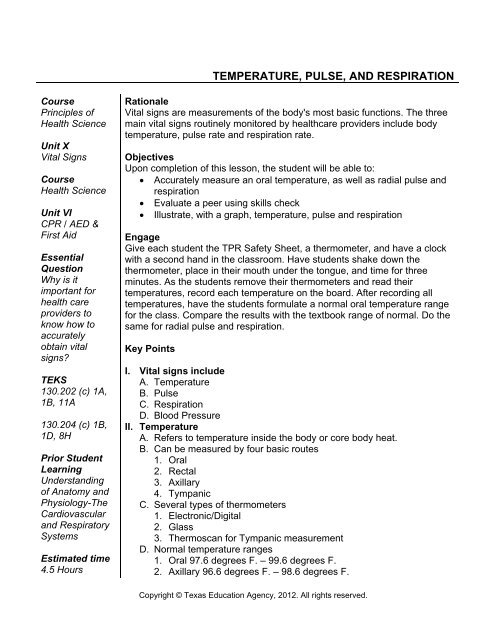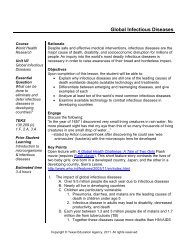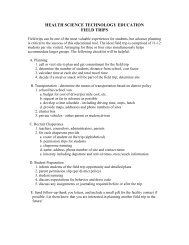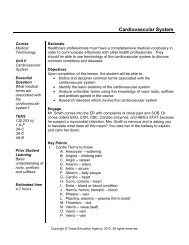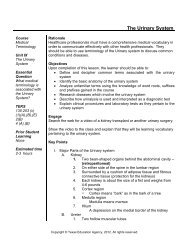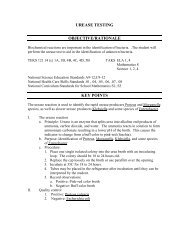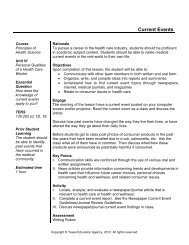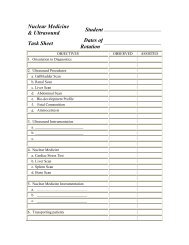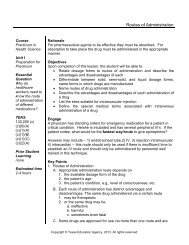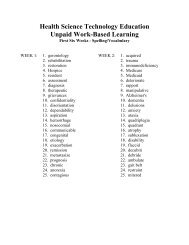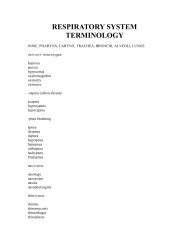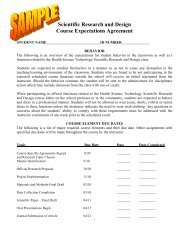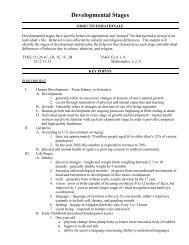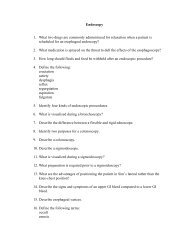Temperature, Pulse and Respiration - Texas Health Science!
Temperature, Pulse and Respiration - Texas Health Science!
Temperature, Pulse and Respiration - Texas Health Science!
Create successful ePaper yourself
Turn your PDF publications into a flip-book with our unique Google optimized e-Paper software.
TEMPERATURE, PULSE, AND RESPIRATION<br />
Course<br />
Principles of<br />
<strong>Health</strong> <strong>Science</strong><br />
Unit X<br />
Vital Signs<br />
Course<br />
<strong>Health</strong> <strong>Science</strong><br />
Unit VI<br />
CPR / AED &<br />
First Aid<br />
Essential<br />
Question<br />
Why is it<br />
important for<br />
health care<br />
providers to<br />
know how to<br />
accurately<br />
obtain vital<br />
signs<br />
TEKS<br />
130.202 (c) 1A,<br />
1B, 11A<br />
130.204 (c) 1B,<br />
1D, 8H<br />
Prior Student<br />
Learning<br />
Underst<strong>and</strong>ing<br />
of Anatomy <strong>and</strong><br />
Physiology-The<br />
Cardiovascular<br />
<strong>and</strong> Respiratory<br />
Systems<br />
Estimated time<br />
4.5 Hours<br />
Rationale<br />
Vital signs are measurements of the body's most basic functions. The three<br />
main vital signs routinely monitored by healthcare providers include body<br />
temperature, pulse rate <strong>and</strong> respiration rate.<br />
Objectives<br />
Upon completion of this lesson, the student will be able to:<br />
Accurately measure an oral temperature, as well as radial pulse <strong>and</strong><br />
respiration<br />
Evaluate a peer using skills check<br />
Illustrate, with a graph, temperature, pulse <strong>and</strong> respiration<br />
Engage<br />
Give each student the TPR Safety Sheet, a thermometer, <strong>and</strong> have a clock<br />
with a second h<strong>and</strong> in the classroom. Have students shake down the<br />
thermometer, place in their mouth under the tongue, <strong>and</strong> time for three<br />
minutes. As the students remove their thermometers <strong>and</strong> read their<br />
temperatures, record each temperature on the board. After recording all<br />
temperatures, have the students formulate a normal oral temperature range<br />
for the class. Compare the results with the textbook range of normal. Do the<br />
same for radial pulse <strong>and</strong> respiration.<br />
Key Points<br />
I. Vital signs include<br />
A. <strong>Temperature</strong><br />
B. <strong>Pulse</strong><br />
C. <strong>Respiration</strong><br />
D. Blood Pressure<br />
II. <strong>Temperature</strong><br />
A. Refers to temperature inside the body or core body heat.<br />
B. Can be measured by four basic routes<br />
1. Oral<br />
2. Rectal<br />
3. Axillary<br />
4. Tympanic<br />
C. Several types of thermometers<br />
1. Electronic/Digital<br />
2. Glass<br />
3. Thermoscan for Tympanic measurement<br />
D. Normal temperature ranges<br />
1. Oral 97.6 degrees F. – 99.6 degrees F.<br />
2. Axillary 96.6 degrees F. – 98.6 degrees F.<br />
Copyright © <strong>Texas</strong> Education Agency, 2012. All rights reserved.
3. Rectal 98.6 degrees F. – 100.6 degrees F.<br />
4. Tympanic: Manufacturer’s guidelines suggest that the<br />
measurement is the same as rectal temperatures.<br />
5. Axillary is one degree Fahrenheit lower than Oral<br />
6. Rectal is one degree Fahrenheit higher than Oral<br />
E. Reading temperatures<br />
1. By degree <strong>and</strong> tenth of a degree<br />
2. Place thermometer at eye level <strong>and</strong> look for silver line of mercury<br />
3. Never place fingers on bulb of thermometer as this might change<br />
the value<br />
F. Thermometers <strong>and</strong> routes<br />
1. Probes for electronic <strong>and</strong> mercury-free ends are color coded for<br />
route.<br />
2. Red = rectal; Blue = oral/axillary<br />
3. If no color present, the route will be written on the thermometer<br />
G. Measurement of temperature<br />
1. Use protective cover on each thermometer<br />
2. Tympanic probe placed in ear<br />
3. Rectal thermometer or probe placed in rectum one inch with<br />
lubrication applied before insertion.<br />
4. Oral thermometer placed in mouth under the tongue<br />
5. Do not take oral temperatures on<br />
a. preschool children<br />
b. patients with oxygen<br />
c. delirious, confused, disoriented patients<br />
d. comatose patients<br />
e. patients with nasogastric tubes in place<br />
f. patients who have had oral surgery<br />
g. patients who are vomiting or are quite nauseated<br />
6. Do not take rectal temperatures on<br />
a. infants or children unless a core temperature is needed<br />
b. patients who have had rectal surgery<br />
c. combative patients<br />
H. Duration of taking temperature<br />
1. Tympanic – a couple of seconds – long enough to gently press a<br />
button.<br />
2. Oral <strong>and</strong> rectal (glass thermometer) – three minutes.<br />
3. Axillary glass thermometer) – 10 minutes<br />
4. Electronic temperatures – when beep sounds, temperature is<br />
obtained<br />
I. Abnormal temperatures<br />
1. Fever, febrile, hyperthermia all indicate someone who has an<br />
elevated temperature (greater than 100 degrees Fahrenheit).<br />
2. High fever would include anything over 103 degrees Fahrenheit.<br />
3. Moderate fever would include anything 100 – 103 degrees<br />
Fahrenheit.<br />
Copyright © <strong>Texas</strong> Education Agency, 2012. All rights reserved.
4. Hypothermia is subnormal temperature. This can be equally<br />
problematic for a person. Anything under 96 degrees Fahrenheit<br />
would indicate hypothermia.<br />
III. <strong>Pulse</strong><br />
A. Wave of blood produced by beating of heart <strong>and</strong> traveling along<br />
the artery<br />
B. Can feel at points where the artery is between finger tips <strong>and</strong> a<br />
bony area<br />
C. These areas are called pulse points <strong>and</strong> include<br />
1. Temporal<br />
2. Carotid<br />
3. Apical<br />
4. Brachial<br />
5. Radial<br />
6. Femoral<br />
7. Popliteal<br />
8. Dorsal Pedalis<br />
D. Measured by index, middle, <strong>and</strong> ring fingers over pulse point.<br />
E. Do not take with the thumb, since it has a pulse of its own.<br />
F. Count for 30 seconds <strong>and</strong> multiply by 2, or count for 60 seconds<br />
G. Normal range is 60 – 100 beats per minute. The area of 90-100 is a<br />
gray area in that a pulse should never constantly remain in this area.<br />
H. > than 100 = tachycardia<br />
I. < than 90 = bradycardia<br />
J. Quality of pulse is determined as well as rate<br />
1. Rhythm – regular or irregular<br />
2. Strength – Bounding or thready<br />
K. Circumstances affecting pulse rate<br />
1. Body temperature<br />
2. Emotions<br />
3. Activity level<br />
4. <strong>Health</strong> of heart<br />
L. Perfusion is the flow of blood throughout the body. Someone with<br />
sufficient perfusion has a strong enough heart beat to adequately<br />
oxygenate the body.<br />
IV. <strong>Respiration</strong><br />
A. Each breath includes inspiration <strong>and</strong> expiration.<br />
B. Measure by observing chest rise <strong>and</strong> fall.<br />
C. Measured in breaths per minute.<br />
D. Normal range = 12-24 breaths per minute.<br />
E. > than 24 = tachypnea – if breathing in great depth then called<br />
hyperpnea<br />
F. < than 12 = bradypnea<br />
G. Difficulty in breathing is called dyspnea<br />
H. Quality of breathing is determined as well as the rate of breathing<br />
1. Depth<br />
Copyright © <strong>Texas</strong> Education Agency, 2012. All rights reserved.
2. Clarity of breath sounds<br />
3. Pain with breathing<br />
4. Difficulty breathing – use of accessory muscles –<br />
sternocleidomastoid <strong>and</strong> intercostal muscles<br />
V. Procedure for taking TPRs<br />
A. If using glass thermometer, insert the thermometer. If axillary or rectal<br />
hold the thermometer throughout the time. If oral, insert the<br />
thermometer <strong>and</strong> proceed to take the pulse <strong>and</strong> respiration.<br />
B. If using electronic – take the temperature first, then proceed to the<br />
pulse <strong>and</strong> respiration.<br />
C. When taking the pulse <strong>and</strong> respiration, do not drop the wrist until both<br />
the pulse <strong>and</strong> respiration are taken. This way the person does not<br />
know when his/her respirations are being measured – insuring a more<br />
accurate measurement.<br />
D. When measuring axillary temperature, remove any clothing that could<br />
impede the accuracy of the temperature. Also clean the axilla if there<br />
is excessive deodorant or perspiration present.<br />
E. When measuring the rectal temperatures, always lubricate the<br />
thermometer with water-soluble gel before inserting into the rectum.<br />
F. Never touch the bulb end of the thermometer with the fingers.<br />
VI. Charting<br />
A. Chart in order of TPR<br />
B. Do not write T =, P =, etc., simply 98.6 – 84 – 22.<br />
VII. Instruct on the correct reading of a glass thermometer<br />
A. Read between the markings <strong>and</strong> numbers.<br />
B. Large lines indicate full degrees.<br />
C. Small lines are two-tenths of a degree.<br />
Activity<br />
I. Practice the combined skill of taking temperature, pulse, <strong>and</strong><br />
respiration by taking the TPR of each class member <strong>and</strong> record it on a<br />
sheet of paper in the format T-P-R <strong>and</strong> on a graphic sheet. See<br />
Graphing TPRs.<br />
II.<br />
III.<br />
Check skill of taking oral temperature, pulse, <strong>and</strong> respiration by<br />
completing a peer evaluation with another classmate (Check 1 on<br />
Skill Examination Checklist).<br />
As students are waiting to test, they will complete<br />
Terminology <strong>and</strong> Abbreviations for <strong>Temperature</strong>, <strong>Pulse</strong>, <strong>and</strong><br />
<strong>Respiration</strong>.<br />
Teachers Note: Obtain a copy of a local facility’s graphic sheet to use<br />
with graphing TPRs<br />
Copyright © <strong>Texas</strong> Education Agency, 2012. All rights reserved.
IV.<br />
* May have HST II or HST III students help with vital signs skills<br />
* May also use HOSA Nursing Assistant Skills Sheets –<br />
www.hosa.org<br />
Complete the Vital Signs Case Study. Answers will vary, but they<br />
should indicate the student’s ability to apply information.<br />
Assessment<br />
I. Successful performance of the TPR skill test in 10 minutes<br />
– Instructor to use Check 2 or HOSA Nursing assistant skills rubric<br />
II. Successful completion of the written objective test.<br />
Materials<br />
Manikin with orifice for insertion of rectal thermometer<br />
Glass, electronic, <strong>and</strong> Thermoscan thermometers<br />
Lubricating jelly<br />
Protective covers for all thermometer types<br />
Clock<br />
Timer for test<br />
Skill checklist<br />
Container for thermometers<br />
Alcohol<br />
Graphic sheet used to chart vital signs (Obtain from your local hospital)<br />
Videos – Mosby’s Nursing assistant Skills Video Series<br />
Sorrentino, Sheila A. Mosby’s Textbook for Nursing Assistants, 5th<br />
edition. St. Louis, Mosby Year Book, 1999.<br />
<strong>Texas</strong> Department of Human Services Curriculum for Long Term Care<br />
Providers.<br />
KEY: Test Vital Signs: TPR<br />
Sorrentino, Sheila A. Mosby’s Textbook for Nursing Assistants, 6th edition.<br />
St. Louis, Mosby Year Book, 1999.<br />
http://www.dads.state.tx.us/providers/NF/credentialing/NATCEP/cna.pdf<br />
(Click on Nurse Aide Curriculum)<br />
Accommodations for Learning Differences<br />
For reinforcement, the student will take 15 TPRs of a biology class in the<br />
high school, analyzing each for any abnormality, <strong>and</strong> submitting their<br />
findings before the skills <strong>and</strong> written test. (oral temperatures)<br />
For enrichment, the student will prepare <strong>and</strong> present a presentation on<br />
temperature, pulse, <strong>and</strong> respiration for an elementary class. See<br />
Presentation Rubric.<br />
Copyright © <strong>Texas</strong> Education Agency, 2012. All rights reserved.
National <strong>and</strong> State Education St<strong>and</strong>ards<br />
National <strong>Health</strong> <strong>Science</strong> Cluster St<strong>and</strong>ards<br />
HLC 10.01 Technical Skills<br />
<strong>Health</strong>care workers will apply technical skills required for all career<br />
specialties. They will demonstrate skills <strong>and</strong> knowledge as appropriate.<br />
TEKS<br />
130.202 (c)(1)(A) convert units between systems of measurement;<br />
130.202 (c)(1)(B) apply data from tables, charts, <strong>and</strong> graphs to provide<br />
solutions to health-related problems; <strong>and</strong><br />
130.202 (c)(11)(A) identify technological equipment used in each of the five<br />
systems <strong>and</strong> relate findings to identified societal risk factors.<br />
130.204 (c)(1)(B) communicate using medical terminology;<br />
130.204 (c)(1)(D) interpret complex technical material related to the health<br />
science industry; <strong>and</strong><br />
130.204 (c)(8)(H) demonstrate first aid, vital signs, cardiopulmonary<br />
resuscitation, <strong>and</strong> automated external defibrillator skills in a laboratory<br />
setting.<br />
<strong>Texas</strong> College <strong>and</strong> Career Readiness St<strong>and</strong>ards<br />
English Language Arts<br />
II. B. Underst<strong>and</strong> new vocabulary <strong>and</strong> concepts <strong>and</strong> use them accurately in<br />
reading writing <strong>and</strong> speaking.<br />
III. B. Develop effective speaking styles for both group <strong>and</strong> one on one<br />
situations.<br />
IV. A. Apply listening skills as an individual <strong>and</strong> as a member of a group in a<br />
variety of settings.<br />
Mathematics<br />
IV. A. 1. Select <strong>and</strong> use the appropriate type of unit for the attribute being<br />
measured.<br />
IV. B. 1. Convert from 1 measuring system to another<br />
IV. B. 2. Convert within a single measurement system.<br />
Social Studies<br />
IV. B. 3. Gather, organize <strong>and</strong> display the results of data <strong>and</strong> research.<br />
Copyright © <strong>Texas</strong> Education Agency, 2012. All rights reserved.
GRAPHING TEMPERATURE/PULSE/RESPIRATION<br />
Using the graphic record that you received in this packet, chart the TPR of each of the students<br />
that you obtained when practicing the skill of measuring temperature, pulse, <strong>and</strong> respiration.<br />
Each student will represent a time slot, as though you obtained TPR every four hours on the same<br />
patient. Connect the lines for each of the graphs. Can you draw any conclusions about the<br />
temperature, pulse, <strong>and</strong> respiration of each of your classmates<br />
Are all temperatures basically within the same range<br />
Using the graph, what would you say the normal range was for oral temperatures What does you<br />
book say is the normal range<br />
Are the pulses basically within the same range Using the graph, what would you say the normal<br />
range was for pulses What does your book say the normal range is<br />
Are the respiratory rates within the same range Using the graph, what would you say the normal<br />
range was for respiration What does you book say the normal range is<br />
Copyright © <strong>Texas</strong> Education Agency, 2012. All rights reserved.
TEST: VITAL SIGNS: TEMPERATURE, PULSE, RESPIRATION<br />
NAME: ___________________________<br />
Fill in the Blank: For each of the questions, write the correct answers in the corresponding blanks<br />
provided.<br />
1. – 4. List the four vital signs of body function.<br />
____________ ___________ ____________ ___________<br />
5. – 8. Give the four routes for measuring temperature.<br />
____________ ___________ ____________ ___________<br />
9. What would you ask a patient before measuring his/her oral temperature<br />
____________ 10. The ____ should not be used to take the pulse because it has a pulse of<br />
its own.<br />
____________<br />
____________<br />
____________<br />
____________<br />
____________<br />
____________<br />
____________<br />
____________<br />
____________<br />
____________<br />
11. Each ____ involves one inhalation <strong>and</strong> one exhalation.<br />
12. The pulse should be taken one full minute if it is ____, a word meaning<br />
abnormal in rhythm.<br />
13. Difficult, labored, or painful breathing is called _____.<br />
14. <strong>Respiration</strong>s <strong>and</strong> pulse are counted for ____ each, unless they<br />
are abnormal in rhythm or rate.<br />
15. The speed of the heart beating or of breathing is called _____.<br />
16. Faster than normal, shallow breathing is called _____.<br />
17. Faster than normal, deep breathing is ______.<br />
18. Slower than normal breathing is ______.<br />
19. No breathing is ______.<br />
20. Normal breathing is ______.<br />
Copyright © <strong>Texas</strong> Education Agency, 2012. All rights reserved.
____________<br />
____________<br />
____________<br />
21. A heartbeat greater than 100 beats per minute is ______.<br />
22. A heartbeat less than 60 beats per minute is ______.<br />
23. The normal respiratory range is __________.<br />
_______________ 24. The normal oral temperature range is ________.<br />
___ _____ ______ 25. We would expect a rectal temperature to be ____ ____<br />
________than an oral temperature.<br />
____________<br />
____________<br />
____________<br />
26. The normal adult pulse range is ______.<br />
27. How far is a rectal thermometer inserted<br />
28. How long is an axillary thermometer left in place<br />
____________________________ 29. – 30. You are taking vital signs of a 65-year-old<br />
woman. Her TPR is 95.7 ® - 56 – 22. Which, if any, of the vital signs would you report<br />
____________________________<br />
31. The abbreviation SOB means ____.<br />
____________<br />
____________<br />
____________<br />
32. If taking a rectal temperature with a glass thermometer, you would choose<br />
the thermometer that is _____ in color.<br />
33. When taking a radial pulse, you would press on the ____ side<br />
of the wrist.<br />
34. <strong>Respiration</strong>s gradually increasing in rapidity <strong>and</strong> volume,<br />
reaching a climax, <strong>and</strong> then gradually subsiding until they cease are known as<br />
________.<br />
Multiple Choice: For each of the following, select the best answer <strong>and</strong> write the letter in the space<br />
provided.<br />
_____35. An oral glass temperature is taken for<br />
a. 5 minutes<br />
b. 3 minutes<br />
c. 2 minutes<br />
d. 10 minutes<br />
Copyright © <strong>Texas</strong> Education Agency, 2012. All rights reserved.
_____36. A rectal glass temperature is taken for<br />
a. 5 minutes<br />
b. 3 minutes<br />
c. 2 minutes<br />
d. 10 minutes<br />
_____37. The most accurate temperature is the<br />
a. oral<br />
b. axillary<br />
c. rectal<br />
d. tympanic<br />
_____38. A temperature of 103 – 105 degrees F. is<br />
a. normal oral<br />
b. high fever<br />
c. normal rectal<br />
d. borderline fever<br />
_____39. A temperature below 96 degrees F. is<br />
a. normal axillary<br />
b. below normal<br />
c. normal oral<br />
d. borderline fever<br />
_____40. A temperature of 100 – 103 degrees F. is<br />
a. normal oral<br />
b. moderate fever<br />
c. normal rectal<br />
d. borderline fever<br />
_____41. A temperature of 99.6 degrees F. is<br />
a. normal oral<br />
b. normal axillary<br />
c. below normal<br />
d. moderate fever<br />
_____42. If a person’s heart doesn’t always beat hard enough to produce a wave of blood, their<br />
pulse would be<br />
a. irregular<br />
b. regular<br />
c. bounding<br />
d. thready<br />
Copyright © <strong>Texas</strong> Education Agency, 2012. All rights reserved.
_____43. The number of pulse, heartbeats, or respirations per minute is<br />
a. quality<br />
b. rate<br />
c. volume<br />
d. vital signs<br />
_____44. Volume, strength of pulse beats<br />
a. quality<br />
b. rate<br />
c. vital signs<br />
_____45. On a Fahrenheit glass thermometer, how many degrees do the short lines indicate<br />
a. 1 degree<br />
b. 2 degrees<br />
c. 0.1 degree<br />
d. 0.2 degree<br />
_____46. If you count the chest rising 15 times in one minute, you would report<br />
a. 30 respirations per minute<br />
b. 15 respirations per minute<br />
c. 7 respirations per minute<br />
_____47. If you count nine respirations in 30 seconds, you would report<br />
a. 27 respirations per minute<br />
b. 9 respirations per minute<br />
c. 18 respirations per minute<br />
_____48. A popliteal pulse is found<br />
a. in the groin<br />
b. behind the knee<br />
c. on top of the foot<br />
d. at the neck<br />
_____49. A femoral pulse is found<br />
a. in the groin<br />
b. behind the knee<br />
c. on top of the foot<br />
d. at the neck<br />
_____50. A temporal pulse is found<br />
a. at the neck<br />
b. at the side of the head<br />
c. at the elbow<br />
d. behind the ear<br />
Copyright © <strong>Texas</strong> Education Agency, 2012. All rights reserved.
_____51. If a person has a blue cast to their nail beds <strong>and</strong> feels cold to the touch, we say they<br />
have<br />
a. a pulse deficit<br />
b. an irregular pulse rate<br />
c. poor perfusion<br />
d. a bounding pulse<br />
_____52. <strong>Temperature</strong>s are not taken orally if a patient is receiving oxygen.<br />
a. true<br />
b. false<br />
_____53. <strong>Temperature</strong>s are taken orally on children younger than 4-5 years of age.<br />
a. true<br />
b. false<br />
_____54. Oral temperatures are not taken on someone who is delerious, restless, confused, or<br />
disoriented.<br />
a. true<br />
b. false<br />
_____55. A rectal temperature is not taken when a person<br />
a. is unconscious<br />
b. needs a core body temperature measurement<br />
c. has a nasogastric tube<br />
d. has had rectal surgery<br />
56. – 60 Record the temperature found on the glass thermometers placed in the classroom.<br />
56.<br />
57.<br />
58.<br />
59.<br />
60.<br />
Copyright © <strong>Texas</strong> Education Agency, 2012. All rights reserved.
KEY FOR TEST: VITAL SIGNS: TEMPERATURE, PULSE, RESPIRATION<br />
2. – 4. Blood Pressure <strong>Temperature</strong> <strong>Pulse</strong> <strong>Respiration</strong><br />
5. – 8. Oral Rectal Axillary Tympanic<br />
10. Have you had anything hot or cold to drink, smoked or chewed gum in the last 15 minutes<br />
10. Thumb<br />
11. <strong>Respiration</strong><br />
12. Irregular<br />
13. Dyspnea<br />
14. 30 seconds<br />
15. Rate<br />
16. Tachypnea<br />
17. Hyperpnea or Hyperventilation<br />
18. Bradypnea<br />
19. Apnea<br />
20. Eupnea<br />
21. Tachycardia<br />
22. Bradycardia<br />
23. 12-24 breaths per min.<br />
24. 97-99 degrees F.<br />
25. One degree higher<br />
26. 60-100 beats per min.<br />
27. 1 inch<br />
28. 10 minutes<br />
Copyright © <strong>Texas</strong> Education Agency, 2012. All rights reserved.
29-30 <strong>Temperature</strong> <strong>and</strong> pulse<br />
31. Short of Breath<br />
32. Red<br />
33. Thumb<br />
34. Cheyne-Stokes<br />
35. B<br />
36. B<br />
37. C<br />
38. B<br />
39. B<br />
40. B<br />
41. A<br />
42. A<br />
43. B<br />
44. A<br />
45. D<br />
46. B<br />
47. C<br />
48. B<br />
49. A<br />
50. A<br />
51. C<br />
52. A<br />
Copyright © <strong>Texas</strong> Education Agency, 2012. All rights reserved.
53. F<br />
54. A<br />
55. D<br />
Copyright © <strong>Texas</strong> Education Agency, 2012. All rights reserved.
TERMINOLOGY AND ABBREVIATIONS FOR TEMPERATURE, PULSE, AND<br />
RESPIRATION<br />
For each of the following abbreviations <strong>and</strong> terms, make a flash card. With a partner, drill the<br />
terms.<br />
Abbreviations:<br />
SOB<br />
qid<br />
_<br />
q<br />
_<br />
s<br />
_<br />
c<br />
TPR<br />
B/P<br />
V/S or VS<br />
q4h<br />
tid<br />
bid<br />
hs<br />
prn<br />
Ad lib<br />
_<br />
qod<br />
_<br />
qd<br />
Terminology:<br />
tachypnea<br />
bradypnea<br />
tachycardia<br />
bradycardia<br />
systole<br />
asystole<br />
eupnea<br />
apnea<br />
hyperpnea<br />
bounding<br />
thready<br />
hyperventilation<br />
dyspnea<br />
fever<br />
febrile<br />
afebrile<br />
angina<br />
wheezing<br />
rales<br />
rhonchi<br />
orthopnea<br />
Copyright © <strong>Texas</strong> Education Agency, 2012. All rights reserved.
Vital Signs Case Studies<br />
Read the scenario <strong>and</strong> determine how the descriptions presented relate to the concepts learned<br />
about vital signs. Analyze your findings to arrive at a conclusion.<br />
You have been assigned to observe with Ms. Roberts, the charge nurse on Medicine 3B. One<br />
patient is a young man, James Donaldson, who is obviously ill. Ms. Roberts tells you that his<br />
temperature is 102 degrees. He has a severe headache. There is no indication of a site infection.<br />
A final diagnosis has not yet been made. The attending physician, Dr. Sampson, comes by to see<br />
the patient <strong>and</strong> says, “I’ll give him a prescription to make him more comfortable, but let’s not start<br />
antibiotics for 12 hours.” Analyze this information to explain the order.<br />
While you were on duty in the Emergency Room, you observed an accident victim with a severe<br />
head injury. The skull was fractured <strong>and</strong> there appeared to be brain injury. His temperature was<br />
105 degrees. Apply the information given to suggest a cause for this temperature elevation.<br />
As you worked in the clinic, a patient came in with a blood pressure of 180/95, a temperature of<br />
100 degrees, <strong>and</strong> a respiration of 30. What range of pulse rate would you expect to find Explain<br />
your answer.<br />
Copyright © <strong>Texas</strong> Education Agency, 2012. All rights reserved.


